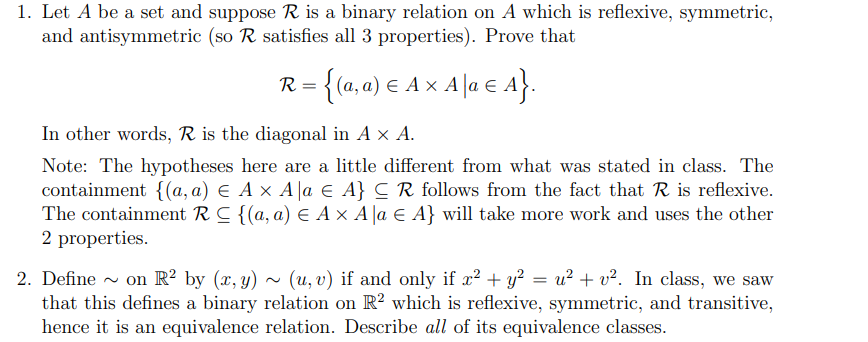1. Let A be a set and suppose R is a binary relation on A which is reflexive, symmetric, and antisymmetric (so R satisfies all 3 properties). Prove that - {(a,a) € A x A |a € A}. In other words, R is the diagonal in A x A. Note: The hypotheses here are a little different from what was stated in class. The containment {(a, a) € A × A|a e A} C R follows from the fact that R is reflexive. The containment R C {(a, a) E A × A|a E A} will take more work and uses the other 2 properties.
1. Let A be a set and suppose R is a binary relation on A which is reflexive, symmetric, and antisymmetric (so R satisfies all 3 properties). Prove that - {(a,a) € A x A |a € A}. In other words, R is the diagonal in A x A. Note: The hypotheses here are a little different from what was stated in class. The containment {(a, a) € A × A|a e A} C R follows from the fact that R is reflexive. The containment R C {(a, a) E A × A|a E A} will take more work and uses the other 2 properties.
Elements Of Modern Algebra
8th Edition
ISBN:9781285463230
Author:Gilbert, Linda, Jimmie
Publisher:Gilbert, Linda, Jimmie
Chapter1: Fundamentals
Section1.7: Relations
Problem 29E: 29. Suppose , , represents a partition of the nonempty set A. Define R on A by if and only if there...
Related questions
Question

Transcribed Image Text:1. Let A be a set and suppose R is a binary relation on A which is reflexive, symmetric,
and antisymmetric (so R satisfies all 3 properties). Prove that
R = {(a,a) € A × A |a € A}.
In other words, R is the diagonal in A x A.
Note: The hypotheses here are a little different from what was stated in class. The
containment {(a, a) E A × A |a € A} C R follows from the fact that R is reflexive.
The containment R C {(a, a) E A × A |a € A} will take more work and uses the other
2 properties.
2. Define - on R² by (x, y) ~ (u, v) if and only if æ² + y² = u² + v². In class, we saw
that this defines a binary relation on R? which is reflexive, symmetric, and transitive,
hence it is an equivalence relation. Describe all of its equivalence classes.
Expert Solution
This question has been solved!
Explore an expertly crafted, step-by-step solution for a thorough understanding of key concepts.
This is a popular solution!
Trending now
This is a popular solution!
Step by step
Solved in 2 steps with 1 images

Recommended textbooks for you

Elements Of Modern Algebra
Algebra
ISBN:
9781285463230
Author:
Gilbert, Linda, Jimmie
Publisher:
Cengage Learning,

Elements Of Modern Algebra
Algebra
ISBN:
9781285463230
Author:
Gilbert, Linda, Jimmie
Publisher:
Cengage Learning,